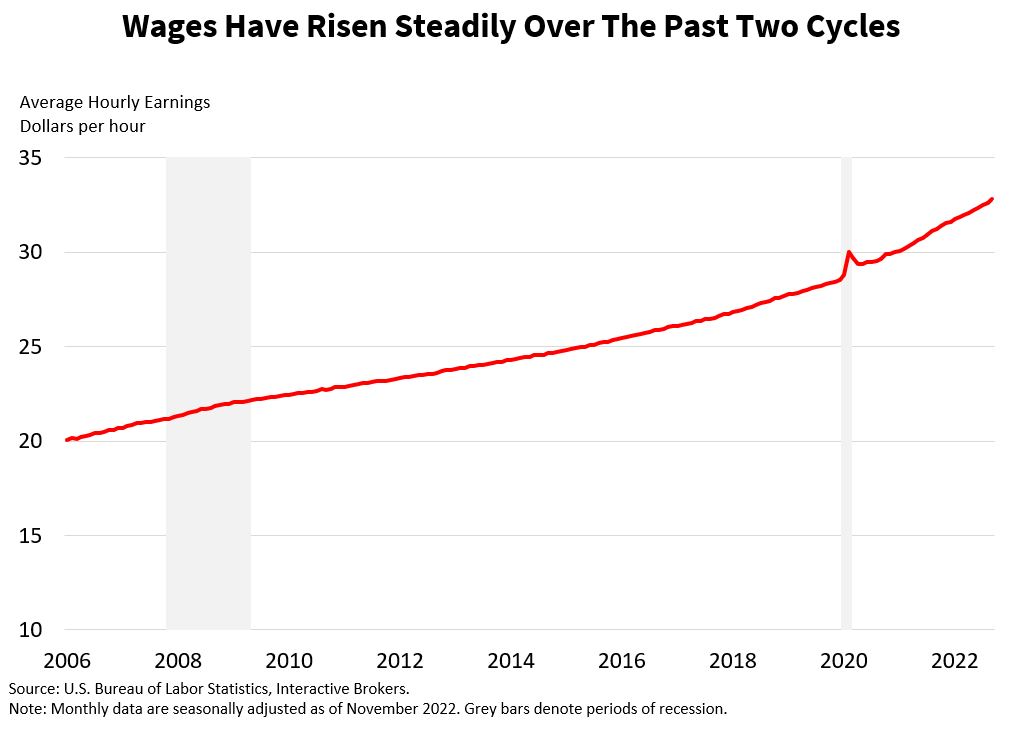Study Notes:
Jose Torres, senior economist for Interactive Brokers. I’ll be explaining one of the economic indicators
of the U.S. economy: Average hourly earnings.
Worker compensation is an important economic indicator because it impacts consumer spending, which accounts for roughly 70% of U.S. gross domestic product, while also being an indicator of the health of the broader economy. On the flip side, wages are a significant input cost when creating products or providing services, so changes in hourly earnings can have a considerable influence upon the business environment and the outlook for inflation.
The U.S. Bureau of Labor Statistics’ Employment Situation Report, otherwise known as the Jobs Report, which includes average hourly earnings, is an important source of information covering labor market activity. The report is issued at 8:30 a.m. eastern time on the first Friday of the month and tracks the hourly earnings of all private employees on a gross basis. It includes overtime pay and late-shift pay but it excludes benefits, bonuses, payroll taxes and retroactive pay. Data is seasonally adjusted and includes month-over-month and year-over-year results.
The Bureau compiles the data by surveying businesses. The BLS measures labor market activity, working conditions, price changes, and productivity in the U.S. economy to support public and private-sector decision making. Wage data is often highly correlated with employment data such as new job creation, unemployment and labor force participation. For example, during the Global Financial Crisis from 2007 to 2009, wage growth slowed alongside increasing unemployment rates and economic contraction.
Overall however, wages have risen overtime alongside prices.

Wage data can influence capital markets as it affects investor sentiment. Higher wages are typically an indication of economic growth, which can be positive for corporate earnings and investor sentiment.
Wage gains can also be favorable for investor sentiment because increased wages strengthen
individuals’ spending capacity, so the data can imply that consumption may increase and that more Americans can afford home ownership. This favorable impact on investor sentiment can be particularly significant when the economy is in an early phase of emerging from a recession and investors are not concerned about inflation.
Trends in average hourly earnings can provide insight into overall labor market conditions and inflation. With that in mind, the Federal Reserve closely monitors the data when setting the federal funds rate. If wages and other data points to concerning levels of inflation, the fed may raise the fed funds rate, which in many instances causes the U.S. dollar to strengthen. As a result, wage increases indirectly influence the strength of the U.S. dollar.
When inflation concerns are mounting, investors may fear that wage growth is worsening price instability and they may believe that what’s good for labor isn’t good for the economy or corporate earnings. Higher wages can cause businesses to pass increased labor costs on to customers by raising product prices, which fuels inflation. In a related matter, companies must balance price increases with competitive factors and the need to maintain sales levels. When businesses can’t increase their prices sufficiently, their profit margins may decline, which can hurt sentiment for equities.
While the report can show if wages are increasing or decreasing, various factors can influence its results. During recessions, lower income workers may represent a disproportionally high level of layoffs. This decrease in the percentages of lower income individuals in the workforce can cause the overall average hourly wage to increase, even when wages are stagnant. In a similar manner, when a large number of employees enter the workforce after a prolonged period of high inflation, the average hourly wage may decline because employees returning to work typically have lower wages than employees who remained employed. That trend was a factor in the slow average annual wage increases occurring during the six or seven years following the Global Financial Crisis and during the COVID-19 pandemic when lower-income workers that couldn’t work from home became unemployed.
Average hourly earnings is released as part of the broader labor report that discusses jobs added, labor force participation and unemployment. When assessed along with those data points, average hourly earnings can influence investor sentiment and is an important aspect of inflation and economic growth.










![[Gamma] Scalping Please [Gamma] Scalping Please](https://ibkrcampus.com/wp-content/smush-webp/2024/04/tir-featured-8-700x394.jpg.webp)




Join The Conversation
If you have a general question, it may already be covered in our FAQs. If you have an account-specific question or concern, please reach out to Client Services.